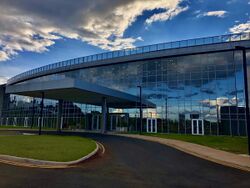Organization:Laboratório Nacional de Luz Síncrotron
 The Sirius particle accelerator building completed in November 2018 | |
| Established | 1997 |
|---|---|
| Research type | high-energy physics |
| Director | Harry Westfahl Jr.[1] |
| Location | Campinas, São Paulo, Brazil [ ⚑ ] 22°48′14″S 47°03′14″W / 22.80389°S 47.05389°W |
| Website | www.lnls.cnpem.br |
Laboratório Nacional de Luz Síncrotron (Portuguese pronunciation: [laboɾɐˈtɔɾju nɐsjoˈnaw dʒi ˈlus ˈsĩkɾotɾõ]; LNLS) is the Brazilian Synchrotron Light Laboratory,[2] a research institution on physics, chemistry, material science and life sciences. It is located in the city of Campinas, sub-district of Barão Geraldo, state of São Paulo, Brazil .
The Center, which is operated by the Brazilian Center of Research in Energy and Materials (CNPEM)[3] under a contract with the National Research Council (CNPq) and the Ministry of Science and Technology of Brazil , has the only particle accelerator (a synchrotron) in Latin America, which was designed and built in Brazil by a team of physicists, technicians and engineers.
Currently, the Brazilian Synchrotron has 6 different beamlines[4] in operation for its user community, covering energies ranging from a few electronvolts to tens of kiloelectronvolts. The uses include:
- X-Ray Nanoscopy [5]
- Coherent and Time-resolsed X-ray Scattering [6]
- X-ray Spectroscopy e Diffraction in Extreme Conditions [7]
- Infrared Micro and Nanospectroscopy [8]
- Resonant Inelastic X-ray scattering and Photoelectron spectroscopy [9]
- Macromolecular Micro and Nanocrystallography [10]
These beamlines are part of Sirius, a 3 GeV synchrotron light source. The plan includes an initial 13 beamlines, with a final goal of 40, ranging from 10 eV to 100 keV. It was inaugurated in 2018.[11]

References
- ↑ "Diretoria" (in pt-br). CNPEM. http://cnpem.br/diretoria/.
- ↑ "History of the Synchrotron Light Sources – LNLS". https://www.lnls.cnpem.br/the-lnls/history-of-the-synchrotron-light-sources/.
- ↑ "The Brazilian Synchrotron Light Laboratory – LNLS". https://lnls.cnpem.br/about/.
- ↑ "Accelerator Commissioning during 2021 and 2022 – LNLS". https://lnls.cnpem.br/sirius-updates/accelerator-commissioning-during-2021-and-2022/.
- ↑ "Carnaúba – LNLS" (in en-US). https://lnls.cnpem.br/facilities/carnauba-en/.
- ↑ "Cateretê – LNLS" (in en-US). https://lnls.cnpem.br/facilities/caterete-en/.
- ↑ "Ema – LNLS". https://lnls.cnpem.br/facilities/ema-en/.
- ↑ "Imbuia – LNLS". https://lnls.cnpem.br/facilities/imbuia-en/.
- ↑ "Ipê – LNLS". https://lnls.cnpem.br/facilities/ipe-en/.
- ↑ "Manacá – LNLS" (in en-US). https://lnls.cnpem.br/facilities/manaca-en/.
- ↑ "Acelerador de Partículas Sirius é inaugurado". https://revistagalileu.globo.com/Ciencia/noticia/2018/11/acelerador-de-particulas-sirius-e-inaugurado-em-cerimonia-oficial.html.
External links
[ ⚑ ] 22°48′14.33″S 47°03′14.28″W / 22.8039806°S 47.0539667°W
 |

